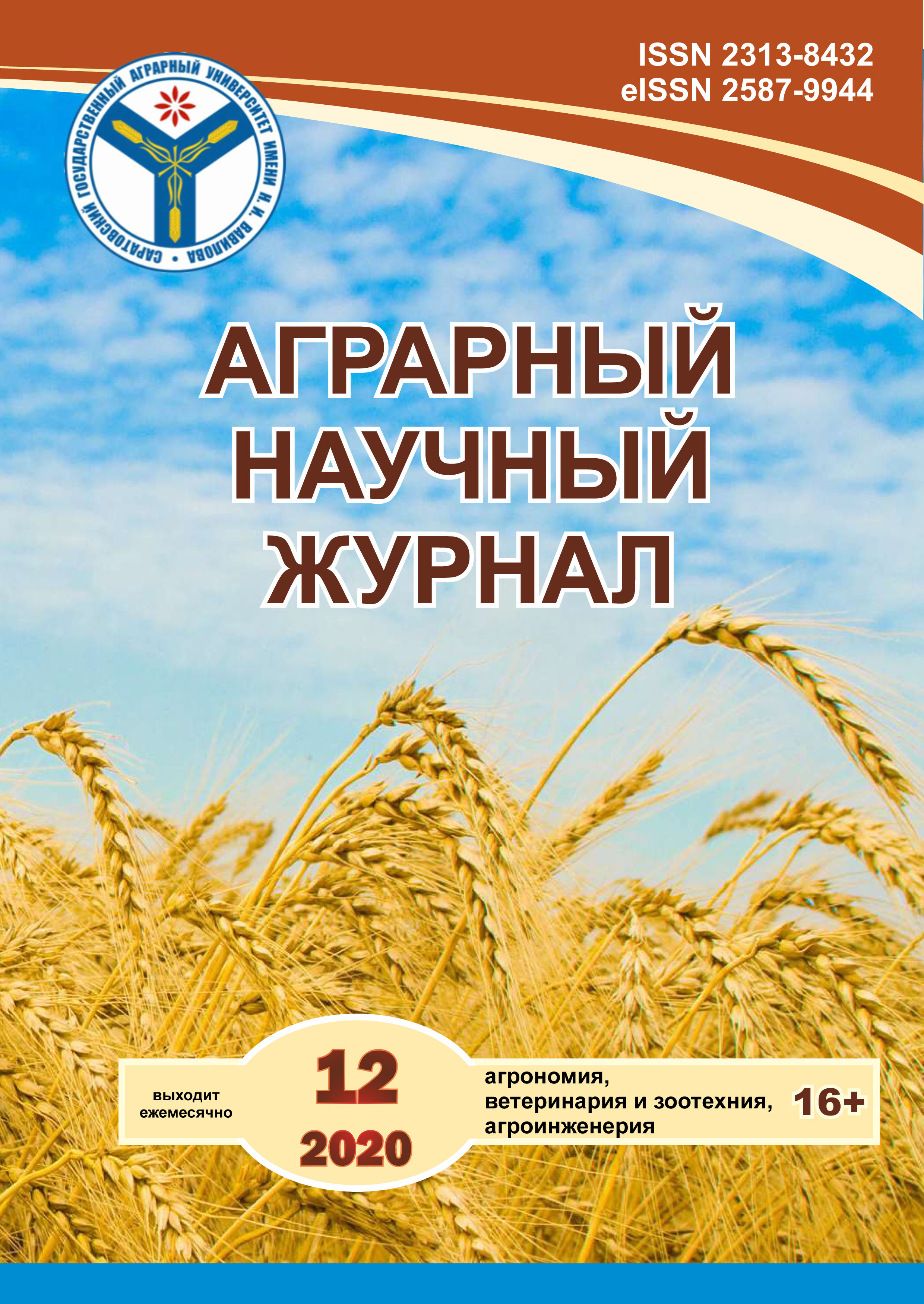The study accessions of green foxtail (Setaria Italica (L.) P. Beauv. Subsp. Italica) for use in feed production in the Lower Volga region
DOI:
https://doi.org/10.28983/asj.y2020i12pp11-13Keywords:
chemise, productivity, protein, fat, gross energy, ash, fiberAbstract
The article presents the results of analysis of the biochemical composition, output of gross energy, biomass and grain of 21 chumiz varieties. In the course of experiments, it was found that the range of variation in the protein content in the biomass is from 5.63to 12.91%. More than 11 % of protein is contained in the dry biomass of the following varieties: k-59, k-73, k-1074, k-2029, k-2542, k-3155, Stachumi-3. The fat content in the biomass varies in the range of 1,01…3,48 %. The highest fat content (>2,5 %) was found in cultivars: k-59, k-2029, k-2542, k-3683, Stachumi-3,UVES.Variability of other indicators of biomass quality in chumiz cultivars was found in the following limits: fiber – 30.77...39.06 %; ash – 5.20...13.94 %; BEV – 35.54...54.07 %. The variation of grain quality indicators is set within the following limits: protein – 11.02...15.36 %; fat – 3.26...6.46 %; fiber – 4.77...9.50 %; ash- 1.85...3.26 %; BEV – 68.83...74.30 %. More than 14 % of the protein in the grain was found in cultivars: k-73, k-941, k-982, k-2029, k-2566, k-2774. A relatively high fat content (>5,0 %) was found in the grain of varietals: k-2542, k-2598, k-2608, k-3155, k-3683, Stachumi-1, UVES. The yield of raw biomass varied in the range of 12.57...26.83 t/ha, and grain 1.00...4.10 t/ha. The output of gross energy per 1 t of biomass in the phase of milk ripeness varies in the range of 3.98…4.31 GJ, and grain 16.37…17.53 GJ. The yield of protein per 1 GJ of gross biomass energy varies in the range of 4.29…7.69 kg, and grain – 6.4…8.05 kg. The highest protein yield per 1 GJ of gross biomass energy was found in cultivars (k-59, k-73, k-1074, k-2029, k-2542, Stachumi-3).
Downloads
References
Вареница Е.Т. Чумиза. Биология, селекция и агротехника. – М.: Сельхоз. изд., 1958. – 432 с.
Гулюшин С.Ю. Химический состав новых сортов зерна чумизы // 43-я Всерос. конф. молодых ученых и семинаров по птицеводству: тез. докл.: ВНИТИП. – Сергеев Посад, 2000. – С. 20–24.
Гвоздова Л.И., Анохина Т.А. Изучение исходного материала чумизы в Беларуси // Земледелие и селекция в Беларуси. – 2012. – № 48. – С. 262–267.
Доспехов Б.А Методика полевого опыта (с основами статистической обработкой результатов исследований). – 5-е изд. доп. и перераб. – М.: Агропромиздат,1985. – 351 с.
Жужукин В.И., Шор М.Ф. Агротехника возделывания могара, пайзы и чумизы // Рекомендации / сост. В.И. Жужукин; ФГБНУ РосНИИСК «Россорго». – Саратов. 2007. – 21 с.
Жужукин В.И., Шор М.Ф., Монина Н.А. Изучение исходного материала могара, чумизы и пайзы в селекции // Селекция, технология возделывания и использование сорговых и других кормовых культур: сборник науч. тр. – Саратов, 2006. – С. 79–83.
Жужукин В.И., Шор М.Ф. Исходный материал для селекции чумизы в Нижнем Поволжье // Кормопроизводство. – 2009. – № 10. – С. 26–27.
Леннова Т.Н., Гулюшин С.Ю. Зерно чумизы в комбикормах для бройлеров // Международная конференция-выставка «Птицеводство – мировой и отечественный опыт». – М., 2002. – 83 с.
Тютюнников А.И. Биологические особенности и основные приемы возделывания суданской травы, чумизы и могара в условиях Московской области: автореф. дис. … канд. с.-х. наук / ВНИИ кормов им. В.Р. Вильямса. – Ленинград, 1952. – 13 с.
Шевцова Л.П., Летучий С.В. Чумиза – ценная кормовая культура для сухостепного Поволжья // Новое в сельскохозяйственном производстве: сборник научных работ СГАУ. – Саратов, 2005. – С. 15–18.
Lenhova T., Guliushin S. Italian millet (chumiza) in broiler diefs // Mtr. 10th Baltic Poultry Converence. – Vilnus, 2002. – 125 p.
Downloads
Published
Issue
Section
License
Copyright (c) 2020 The Agrarian Scientific Journal

This work is licensed under a Creative Commons Attribution-NonCommercial 4.0 International License.








